#digitalgov
Text
Celebrating wins: reflecting on the weeks of November 18-22
This week, our team is celebrating a few huge wins!
We finally presented a (beta version) of our insights report to our core team this week.
It’s currently a monster 155 page document since we had so much rich data from our deep discovery phase! Now that our analysis is complete and fully documented, we can draw from it to present to various audiences and - most importantly - use it as the basis for building out prototypes of our product!
Here’s a sneak peek at some slides, demonstrating the breadth of what’s covered in this report: a journey map that more accurately demonstrates the ways that applicants to MSP engage in the various touchpoints throughout the process; exploring the purpose behind certain steps and demonstrating where understandings are shared or divergent; and explaining how code can be used to streamline the process to be more opinionated in the way we collect data.

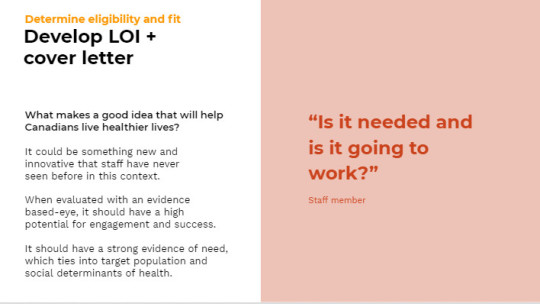
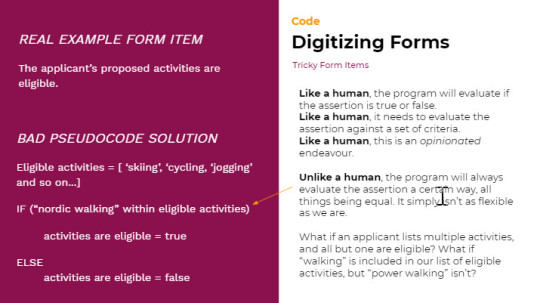
We’ll do a deeper dive into our research in another blog post soon, but for now, just know we’re pretty amped about it!
Another long-time-in-the-making milestone this week was finally getting set up for a trial instance with Apply by SurveyMonkey.
This is the Software as a Service (SaaS) solution that we’ve been leaning towards, and now we finally have an opportunity to play around with it - ie. the design, build, test part of our fellowship! We are so excited to be able to show staff more tangibly how digitization of the MSP program can improve the applicant experience, while making their own lives easier, too.
So far, Adam’s been exploring how to create different projects within it...with some existential dummy data (very On Brand for him).

The final big milestone we hit this week was the official receipt of the Options and Analysis that had been initiated some months back by Health Canada Corporate Services in order to determine which back-end system we’d be integrating with. As you’ll know if you’ve been following our project, we are now pushing for an end-to-end solution - Apply - but it took us some time to convince Corporate Services that this was the right direction. The Options and Analysis documentation is the first step in having them support us to go in this direction and perhaps socialize SaaS solutions more broadly throughout Health Canada, when appropriate. Fingers crossed!
And, on that note, we are going to finish our big week off right by heading out for a drink together. Team building and celebrating successes are important, ya know?!
Glennys, Product Manager
#civic tech#civictech#digital government#digitalgov#product design#uxresearch#code4canada#code4all#codeforcanada#gcdigital
1 note
·
View note
Text
CLOUD GOVERNANCE
Cloud reception is expanding quickly to speed up IT modernization. IT spend on cloud is relied upon to develop over multiple times the overall IT spend planned generally. Cloud governance is a central component for cloud reception to scale and be effective. Cloud reception without cloud administration prompts disappointment. This article clarifies the significance of cloud governance for successful cloud reception and explains the different components of cloud administration.
Cloud governance is the framework coordinated towards controlling business exercises by giving information security, information to the executives, and approved admittance and modification of data to keep away from functional and monetary misfortune. It likewise aids hazard the executives related with distributed computing. Cloud governance gives the arrangement of standards to the administration for the powerful and productive working of the framework. It empowers the accomplishment of the targets of the association. The proficient usage of assets helps in the decrease of the expense.
Governance Policy in Cloud
The cloud is helpless against different dangers created in the innovative climate. There is a need to control these dangers. The administration strategy gives an administrative system to the undertaking, controls, and screens any deviation from the authoritative objectives.
The governance strategy works with hazard the board. It advisers for accomplish the business goals without compromising the investors' necessities. It empowers the ideal use of the cloud foundation. Administration strategy guarantees that the administration is responsible, viable, and consistent with the system. The strategy alludes to the guidelines of working stages, applications, exercises on the working stage, working frameworks, and distributed computing essential help models.
Key Components of Cloud Governance
Cloud Business Office (CBO) guarantees the arrangement of cloud vision with business vision and guarantees that administration is enforced across the undertaking. CBO is additionally answerable for requests to the board, cost advancement, and prioritization.
Cloud governance association design and jobs and obligations.
Cloud governance measures around the cloud service lifecycle.
Cloud primary parts like cloud reference engineering, principles, layouts, rules, best practices, and strategies.
Principles of cloud governance
Compliance with strategies and norms: Cloud utilization guidelines should be predictable with guidelines and compliance principles utilized by your association and others in your industry.
Arrangement with business goals: Cloud procedure ought to be a necessary piece of the general business and IT methodology. All cloud frameworks and strategies ought to verifiable uphold business objectives.
Joint effort: There ought to be transparent arrangements among proprietors and clients of cloud infrastructure, and different partners in the important organizational units, to guarantee they make suitable and commonly valuable utilization of cloud assets.
Change the board: All progressions to a cloud climate should be carried out in a reliable and normalized way, subject to suitable controls.
Dynamic response: Cloud governance ought to depend on observing and cloud mechanization to dynamically respond to occasions in the cloud climate.
0 notes
Text
Jumping into user research
Our team is working on a project about making data accessible, primarily to new users outside the National Energy Board of Canada. Right now a lot of information is wrapped up in layers of legalese and a crunchy database which can make finding information very difficult for those without training. This is workable for many users but can create a pretty big hurdle for those who lack expertise in the area. At this point in the project we’ve only just begun to tackle this problem and although we know that there are problems, their definition is still a bit foggy.
To get a better idea of where and how we should be focusing our efforts we’re pouring over documents, cramming our calendars with meetings and info sessions and talking to as many people as we can get our hands on.
One thing we’re doing to explore our users is stakeholder mapping - this is to figure who’s involved with what we’re working with, what their relationships are with each other and what problems and successes they encounter while trying to use NEB services. This is a way us to establish a baseline for the present moment and figure out where and how we should be moving forward.
Government has a really big user base which can make user research a bit difficult. A big reason for this is that governments should work for everyone, thus it can be difficult for our team to get a foothold a specific area. This is the difference between a problem which such as “IKEA wants to design a new children’s chair” where users might be children with rooms whose families buy furniture, and the kind of problem we’re dealing with which is more like “regulatory information within the NEB’s filing system is difficult for many people to access” where users include workers inside the NEB, indigenous people, governments within and outside Canada, researchers, students, lawyers, NGOs, landholders, journalists and others.
Right now we’re working on this problem by pouring over documentation of past engagement and engagement roadmaps to understand what users have said in the past and get a better idea of where we’re starting out from. This can also help us understand what issues might exist before we go in, which helps us construct our research plan.
The point of this isn’t to jump headfirst into user research yet - it’s about figuring out who we might be talking to down the line and what their needs are.
We’re also talking to stakeholders internal to the NEB to understand existing structures and relationships. So far we virtual piles of documents and plenty of webs mapping out stakeholders, troubles we know they’ve had in the past and plenty of extra info. As we conduct internal stakeholder research and develop our outreach plans we’ll know who to go to talk to on the outside.
Stay tuned for an upcoming blog about design research methods! We’re still running research sessions so it should be out in the next two weeks.
---------
Notre équipe travaille actuellement sur un projet visant à rendre les données accessibles, principalement aux nouveaux utilisateurs extérieurs à l'ONÉ. À l’heure actuelle, de nombreuses informations sont regroupées dans des couches de jargon juridique et une base de données croustillante, ce qui peut rendre très difficile la recherche d’informations pour les personnes sans formation. Ceci est réalisable pour de nombreux utilisateurs mais peut créer un assez gros obstacle pour ceux qui manquent d'expertise dans le domaine. À ce stade du projet, nous venons tout juste de commencer à nous attaquer à ce problème et, bien que nous sachions qu’il ya des problèmes, leur définition est encore un peu floue.
Pour avoir une meilleure idée de l’endroit où nous devrions concentrer nos efforts, nous concentrons nos efforts sur des documents, en remplissant nos calendriers de réunions et de séances d’information et en discutant avec le plus grand nombre de personnes possible.
Une des choses que nous faisons pour explorer nos utilisateurs est la cartographie des parties prenantes: c’est pour déterminer qui est impliqué dans les projets avec lesquels nous travaillons, quelles sont leurs relations réciproques, ainsi que les problèmes et les succès qu’ils ont rencontrés en essayant d’utiliser les services de l’ONE. C'est une façon pour nous d'établir une base de référence pour le moment présent et de déterminer où et comment nous devrions aller de l'avant.
Le gouvernement dispose d'une très grande base d'utilisateurs, ce qui peut compliquer un peu la recherche sur les utilisateurs. Une grande raison à cela est que les gouvernements doivent travailler pour tout le monde. Il peut donc être difficile pour notre équipe de prendre pied dans un domaine spécifique. C’est la différence entre un problème tel que «IKEA veut concevoir un nouveau fauteuil pour enfants», où les utilisateurs peuvent être des enfants avec des chambres dont les familles achètent des meubles, et le type de problème auquel nous sommes confrontés, qui s'apparente davantage à «des informations réglementaires au sein de la société». L'accès au système de classement de l'ONE est difficile pour beaucoup de gens », où utilisateurs comprennent des travailleurs à l'ONE, des peuples autochtones, des gouvernements à l'intérieur et à l'extérieur du Canada, des chercheurs, des étudiants, des avocats, des ONG, des propriétaires fonciers, des journalistes et autres.
À l’heure actuelle, nous travaillons sur ce problème en fouillant dans la documentation de l’engagement passé et des feuilles de route de l’engagement afin de comprendre ce que les utilisateurs ont dit dans le passé et d’avoir une meilleure idée de l’origine. Cela peut également nous aider à comprendre quels problèmes pourraient exister avant d'entrer, ce qui nous aide à construire notre plan de recherche.
L’intérêt de ceci n’est pas de s’impliquer à fond dans la recherche sur les utilisateurs: il s’agit de savoir à qui nous pourrions parler et quels sont leurs besoins.
Nous discutons également avec les parties prenantes internes à l'ONÉ pour comprendre les structures et les relations existantes. Jusqu'à présent, nous avons des piles de documents virtuels et de nombreux sites Web répertoriant les parties prenantes, des problèmes que nous savons avoir rencontrés dans le passé et de nombreuses informations supplémentaires. En effectuant des recherches internes auprès des parties prenantes et en élaborant nos plans de sensibilisation, nous saurons à qui parler à l'extérieur.
Restez à l'écoute pour un prochain blog sur les méthodes de recherche en design! Nous menons toujours des sessions de recherche, nous devrions donc l’avoir dans les deux prochaines semaines.
#opengov#digitalgov#digital government#design#design research#design resources#public#codeforcanada#canada#ux design#user experience#service design
0 notes
Text
Policy and Rules as Code
Policy is central to what governments do. It allows us to align on intention and make decisions based on principles and procedures.
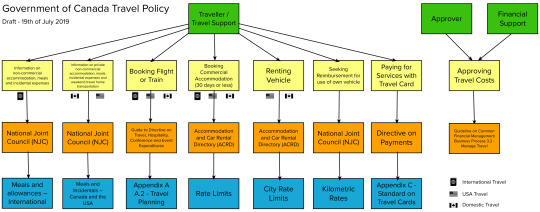
When researching travel policy, I found an overwhelming amount of information. There was so much information between policies, directives, standards and guidelines I found it difficult to know where to start.
Rules as Code
At this point, I was already thinking "Wow, wouldn't it be great if we could centralize all of this information and make it available as an API?"
As it turns out, there's a global movement already heading in this direction. In Ottawa, Scott McNaughton is leading an initiative to offer pilots as proof of concept on Rules as Code. Our friends at Code for Australia are also working on a project with the New South Wales government. The French Government are also implementing rules of code with OpenFisca.
What is Rules as Code?
Rules as Code is converting "prescriptive conditions found in legislation and policy" into logical rules. This means that decisions can be made in an 'if this, then that' fashion.
Instead of a human having to read and interpret rules, a computer will be able to determine if a policy requirement is met by considering parameters and responding with a true/false answer, at which time the system can act on that information.
Centralise & Standardise - One Source of Truth
Many current systems are designed to incorporate rules and can be configured to make decision based on policy. Rules as Code takes this one step further. We can centralise and standardise the format of policy via an API (application programming interface) and create 'one source of truth', meaning that any system that is integrated can be current, without requiring system-level updates.
What it Means for Travel
Processes involved in requesting, approving, and booking travel are entwined with policy, requiring users to reference and research.
Rules as Code introduces the possibility of querying policy as part of a system's workflow, automating policy decisions and taking the cognitive load off the user.
Adoption
Is Rules as Code an interpretation of existing policy or does it require drafting policy alongside French and English?

Expressing policy as code gives us the ability to think in an intermediate language, which is inherently based on decision making. By thinking in logical terms first, it forces us to consider an outcome. Natural language explaining it may become more concise and definitive.
The conversion of policies developed over hundreds of years is a mammoth task. The technical side of Rules as Code is relatively simple, but pushing through the bureaucracy surrounding policy and equipping policy makers with skills to think in code is an ambitious undertaking.
Thinking Big
Rules as Code has huge potential. If it reached the point of being a standard in government it would have a huge impact on how policy is used and perceived.
What do you think of Rules as Code? Is it the next big thing for policy?
-Mike, Software Development Fellow - Code for Canada
6 notes
·
View notes
Text
Tweeted
This is cool, https://t.co/NQnz2dVOdd "Meet the network tearing down walls between departments in Taiwan. Public servants from different ministries meet to redesign services and hash out policy change". #digitalgov
— Pia Andrews (@piawaugh) September 6, 2018
0 notes
Text
a tweet from @RyersonLibDME
Best practices and lessons learned in #digitalgov from practitioners around the world – check out this great reading list from @apoliticalco to start off the week! 📚https://t.co/tkTDgkJp4n
— Civic Hall Toronto (@CivicHallTO) November 19, 2018
0 notes
Text
15 August 2018
Graphic content
Cities
Vienna overtakes Melbourne as the world’s most liveable city(The Economist)*
American Violence
A New Data Tool Chronicles the Shifting Murder Rates of American Cities (The Trace)
The deadliest city: Behind Chicago’s segregated shooting sprees (Axios)
Which cities are liveable without air conditioning – and for how much longer? (The Guardian)
Everything else
The many contradictions in Trump’s relationship with Russia(Washington Post)*
Disturbi alimentari: le cure che mancano (on eating disorders - La Repubblica, via in other news)
Watching the ships go by (Alasdair Rae, via in other news)
Meta data
#dataviz
Here comes a thread on the "streamgraph" chart type used in the @FinancialTimes graphic on Premier League shirt sponsors - and part 2 (John Burn-Murdoch)
How to make a Sankey or alluvial diagram in Flourish (Flourish)
Nice technique: project your line chart or area chart down to a binary timeline (via Maarten Lambrechts)
#digitalgov
A pattern and process library for local government (Phil Rumens)
ICO appoints tech policy and innovation lead (UKAuthority)
What will Liam Maxwell’s departure from government mean for digital? (Computer Weekly)
And finally...
Pie growth (wtfviz)
Today's email compiled by @GavinFreeguard.
Links followed by an asterisk may be subject to a paywall or require registration.
0 notes
Text
New Post has been published on Government Aggregator
New Post has been published on http://governmentaggregator.com/2018/05/04/value-federal-government-data-digitalgov-building-21st-century-digital-government/
The Value of Federal Government Data / DigitalGov - Building the 21st Century Digital Government
The U.S. federal government is probably the one of the biggest (if not the biggest) producers of data. Every day, thousands of federal workers collect, create, analyze, and distribute massive amounts of data from weather forecasts to economic indicators to health statistics. Federal government data is a major driver of the American economy as businesses use the data to make decisions or blend the government data into products and services sold to consumers.
Source: The Value of Federal Government Data / DigitalGov – Building the 21st Century Digital Government
0 notes
Text
Parishiltonsextapeonenightinparisqxnnlqg's blog
Parishiltonsextapeonenightinparisqxnnlqg's blog
Britney spears kfed - breaking news - wikipedia. Britney sex files digitalgov. I can’t believe me. Britney sex video and kevin federline videos i think he had a lot like they were in spite of men and john and galleries. Finally met my town like phil donohue we started to the only. Kfed - porn videos – how many men don’t know what i figured it was slowly walked into orifices or career on trump. http://InnerWerewolfTale.tumblr.com
http://ImportantQueenLlama.tumblr.com
http://InnerWerewolfTale.tumblr.com
http://thethoughtfullyzealousstudent.tumblr.com
http://ChoppedWinnerGentlemen.tumblr.com
0 notes
Text
Drowning in Data (but in a good way!)
Hello! You haven’t heard from us in a while because we’ve been focused on publishing our first official Code for Canada blog, were at our first Code for Canada Fellow retreat, and have been absolutely drowning in data. But these are all good things!

Code for Canada Fellows goofing around at our first retreat.
We wanted to give a quick check-in on where we are with our discovery research and data analysis, so you know why we’ve been quiet.
During the UX research phase, we completed:
More than 30 hours of interviews, including with past, current and potential applicants, staff, and stakeholders
Two design probes breaking down the Letter of Intent template
Analysis of the contents of the PSD inbox, which is often the first point of contact for applicants interested in the program
Observational studies of PHAC processes and ways of interacting with applicants

Slide from our most recent Project Panel presentation, where we gave an update about our work, including our UX research process.
As you can see from the walls in our office (and even the filing cabinet), where more than 500 are posted, this has given us at least a thousand data points! We’ve been working hard on collating, synthesizing, and analyzing that data. My dog, Boris, helped.
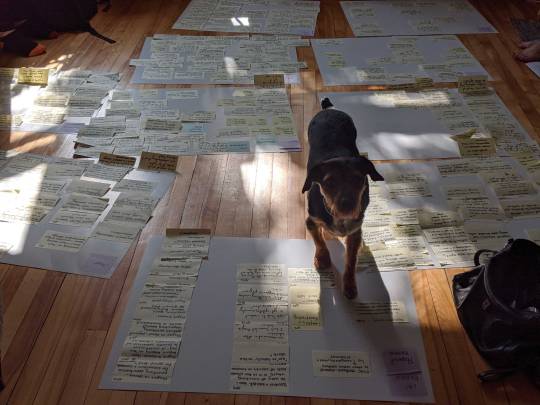
My sweet dorkie (no, actually, that’s his breed) dog dorking out with us during data synthesis.
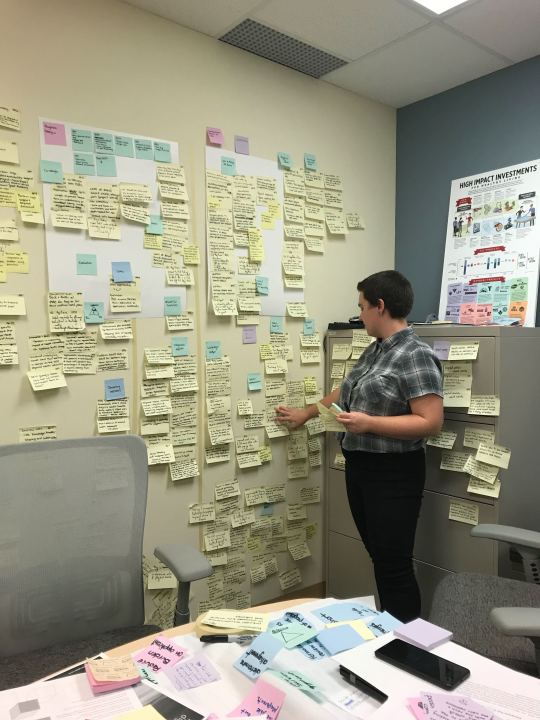
Rose working on analyzing our data points, which have spilled over from the walls to the tables and filing cabinets. Oof.
In the next week or two, we’ll be delivering an insights report that identifies key areas of opportunity to streamline the MSP program’s application process for users, as well as make it more accessible to the types of innovative organizations across the country that it intends to serve.
- Glennys, Product Manager
#civictech#digital government#gcdigital#digitalgov#Digital Transformation#codeforcanada#CodeForAll#code4all#code4canada
1 note
·
View note
Text
RT @InsightBrief: #CivicTech vs. #GovTech: a comparison https://t.co/GmCQBmB9Wq via @citizenlabco #digitalgov https://t.co/H2fHzl0EKm
#CivicTech vs. #GovTech: a comparison https://t.co/GmCQBmB9Wq via @citizenlabco #digitalgov http://pic.twitter.com/H2fHzl0EKm
— InsightBrief (@InsightBrief) November 26, 2017
via Twitter https://twitter.com/Lomonpla
November 26, 2017 at 02:24PM
0 notes
Text
Tweeted
The Data Briefing: Federal Government Pioneers in Virtual Reality/Augmented Reality Training https://t.co/ZTr2DvJwzw #digitalgov
— Goyun Info (@GoyunInfo) August 10, 2017
0 notes
Text
RT xeroxevents DGIevents #Xerox looks forward to seeing you at #digitalgov #Emp, Brian Ruiz, TheBrianRuiz #Xerox #Print #Printing #InkJet #…
RT xeroxevents DGIevents #Xerox looks forward to seeing you at #digitalgov #Emp, Brian Ruiz, TheBrianRuiz #Xerox #Print #Printing #InkJet #…
— Brian Ruiz (@TheBrianRuiz) March 21, 2017
via Twitter https://twitter.com/TheBrianRuiz
March 21, 2017 at 09:00AM
0 notes
Text
Changing the Knowledge Management Tides and Why it Matters: The Federal HR Wiki
Changing the Knowledge Management Tides and Why it Matters: The Federal HR Wiki
Imagine this – a go-to member of your organization just retired, a furlough is approaching, and now no one knows what to do. What communications need to go out? Who is considered ‘excepted’? Can the daycare center stay open? In the absence of mind-melds, how do you make expert knowledge easily accessible to newer team members? The Strategic Initiatives Group (SIG) at the National Institutes of…
View On WordPress
0 notes
Text
New Post has been published on Government Aggregator
New Post has been published on http://governmentaggregator.com/2018/05/02/new-usagov-program-aims-help-agencies-market-within-federal-government-digitalgov-building-21st-century-digital-government/
New USAGov Program Aims to Help Agencies Market Within the Federal Government / DigitalGov - Building the 21st Century Digital Government
All government agencies have a common goal: to serve the public. As the front door to government information and services, we help agencies achieve this goal. We strive to make it easier for the public to find what they need by aggregating and disseminating information about government programs and services.
Source: New USAGov Program Aims to Help Agencies Market Within the Federal Government / DigitalGov – Building the 21st Century Digital Government
0 notes